There are over 60 manufacturers of dental implants and materials used to create restorations such as abutments and crowns. For this reason, dentists have a variety of options to find the implant treatment that is best for the specific needs of their patient. That said, if you go to a particular dentist to have the post implanted, but see a different one for abutment/crown placement or repairs, the latter may not have enough experience, be familiar with or have access to the same components that the first dentist used. This can further complicate an already complex process and make the procedure even more expensive.
In This Guide
- Subperiosteal Implants
- Endosteal Implants
- Two-Stage Dental Implants
- Single-Stage Implants
- Immediate Loading
- Types of Surface Treatments
- Connectors
- Sizes
- Dental Professionals Who Perform the Surgery
- What to Read Next
Dental implants are categorized either by their shape and placement or by the procedure used to place them (single or two-stage).
Subperiosteal Implants
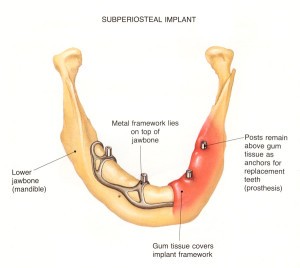 Subperiosteal implants are commonly used for single stage procedures. They are positioned inside the gum tissue on the jaw bone. The post protrudes from the gums to hold the restoration. The primary advantage of this type of implant is that it can hold dentures securely for individuals who do not have enough bone height.
Subperiosteal implants are commonly used for single stage procedures. They are positioned inside the gum tissue on the jaw bone. The post protrudes from the gums to hold the restoration. The primary advantage of this type of implant is that it can hold dentures securely for individuals who do not have enough bone height.
Endosteal Implants
These dental implants are the most commonly used for two-stage procedures. They are surgically implanted directly into the jaw bone and are an alternative to bridges or detachable dentures. As seen below, they come several types including screw/threaded, cylinder/smooth and bladed.
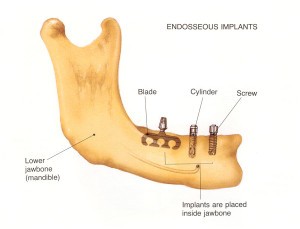
Two-Stage Dental Implants
The two stage procedure is the most commonly practiced method. The implant is surgically placed in the jaw bone so that it lies flush with bone underneath the gum. The gum tissue is then closed with stitches to protect the implant from force while the surrounding bone heals and fuses to it. After a period of healing, a second (minor) surgery is conducted to uncover the implant in order to attach the abutment and temporary restoration.
Single-Stage Implants
This method involves a longer one-piece implant that protrudes through the gum once it is placed in the jaw bone. After the healing period the abutment and crown can be placed without additional surgery to uncover the implant. Alternatively, a two piece implant like the one in the two stage procedure can be used. The implant and healing abutment are immediately connected during the initial surgery. The downside of this method is that the implant is vulnerable to external forces and extra caution must be taken to make sure that the healing process is not interfered with.
Research has shown that both one and two stage procedures have similar rates of success. Ask your dentist or oral surgeon which approach they use and discuss which type would benefit or be appropriate for your particular situation.
Immediate Loading
In carefully selected cases, the implant and restoration are both placed during a single surgery. The implant is surgically placed immediately following extraction of the tooth and placement of the crown follows shortly after. Sufficient bone volume and density are required in order to be a candidate for this procedure.
Types of Surface Treatments
The vast majority of dental implants are made of titanium, but the surface material of the implant varies. The material used is a major factor in the treatment’s stability and long-term strength. A porous surface enables more bone contact compared to a smooth titanium surface. The other types of implant surface treatments are acid-etched or grit-blasted and roughened surface, plasma-sprayed hydroxyapatite coating, and a plasma-sprayed or microgroove titanium surface.
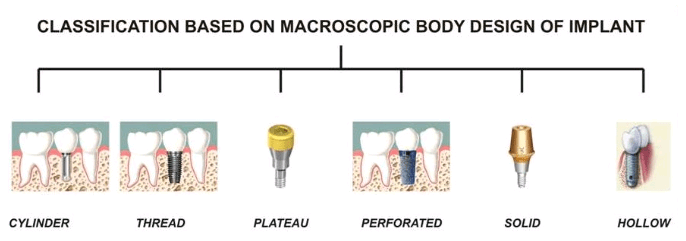
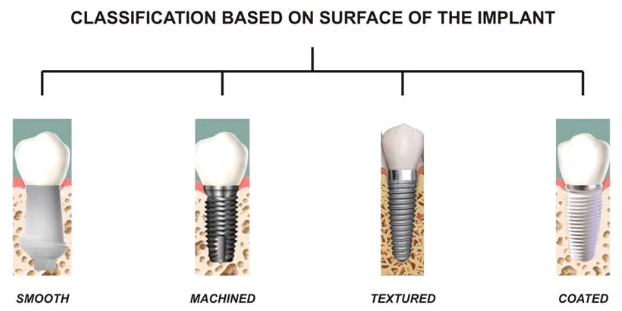
Connectors
Dental implants can also be classified according to their head’s type or shape. The abutment and restoration must be screwed or attached to the implant head with one of the following three main types of connectors:
Internal hex connectors – These connectors have a hexagonal shape and are an opening in a dental implant’s head that the dentist screws the abutment or restoration into.
External hex connectors – These hexagonal shaped connectors are located on top of the dental implant’s head.
Internal octagon connectors – These octagonal shaped connectors are has an opening in the dental implant head that the dentist screws the abutment or restoration into.
Sizes
Implants may be identified according to their size (platform). This can determine where they can be positioned inside the mouth. Each case is different though, so the size used depends on a person’s spacing and bone availability.
Standard platform implants – have a diameter ranging from 3.5 mm to 4.2 mm. They are usually placed in the front part of the mouth.
Wide platform implants – these implants, which have a diameter ranging from 4.5 mm to 6 mm, are typically placed in the back of the mouth to replace molars.
Mini or narrow implants – have a diameter that ranges from 2 mm to 3.5 mm. They are placed in individuals who do not have enough space between the roots of their teeth for a regular sized implant. They are also used when the patient does not have sufficient bone density.
Dental Professionals Who Perform the Surgery
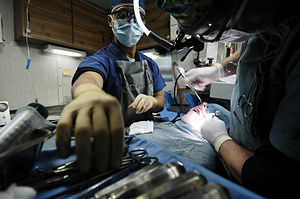 Oral surgeons and periodontists are trained to perform the surgical procedure. There are also many general dentists who have gone through the necessary education and training required to perform the procedure. Crown, implant, and oral surgery training provided by private organizations can be completed in a relatively short time. Widely recognized organizations such as the American Association of Oral and Maxillofacial Surgeons and the American Academy of Periodontology provide more extensive training.
Oral surgeons and periodontists are trained to perform the surgical procedure. There are also many general dentists who have gone through the necessary education and training required to perform the procedure. Crown, implant, and oral surgery training provided by private organizations can be completed in a relatively short time. Widely recognized organizations such as the American Association of Oral and Maxillofacial Surgeons and the American Academy of Periodontology provide more extensive training.
These are the things that you need to consider when you plan to undergo an implant procedure. It is very important to choose a dentist who knows what they’re doing, so don’t be afraid to ask them about their previous experience and where they were trained. It is also important to note that dentists are not required to have a special license to perform a dental implant procedure. General dentists can perform the restoration of a crown and bridge, which is part of the implant treatment, and they can place the implant themselves.
What to Read Next
- How to Much Do Dental Implants Cost?
- What Are Mini Dental Implants?
- All-on-4 Dental Implants Cost & Procedure
- How to Save Money on Dental Implants
- How Painful are Dental Implants?
Over to You
What type of implants are you considering (or already have)? Let us know in the comments!
I wanted dental implants for all of my upper mouth. I got 3 estimates and finally went to a DDS who charged me $4995.00. There are 4 titanium posts in my mouth and on top of that is placed a denture which has to come out daily in order to clean. The procedure was done July’2015 and already the dentures need relining. Is this common and is this truly an implant? The denture is made of the same material as dentures so I really feel I was misled.
I am 22 years old , female , with no medical history. My upper left cental incisor are missing due to trauma since 10 years. Bone grafting is done wrt 21 ( 1.5 year back) . Alveolar bone height is 13mm and width 6.32mm , and i am going through my orthodontic treatment. Its almost complete . My CBCT and treatment planing is done . The implant material they are using is neobiotech lifecare . Is this is good implant material for anterior teeth ?? If all the angulation and placment is right,does this material will make any differences?? I am getting my treatment from govt
I know implants are titanium but the tops that the dentures snap on to are different.
Mine looks gold. Do you have any idea of that metallic makeup?
Tina, I can tell you from experience, mixing metals is “not” a good thing!! Incompatibility can end up causing you big problems down the road!! I can share some of the info I’ve found. Just let me know.
I am 68 and in good health. Ten years ago my 6-tooth bridge with two anchor teeth came out after 30 years. The dentist I went to added two more teeth to fabricate an 8-tooth bridge with four anchor teeth. After seven years the bridge came out and the dentist reattached it using metal pins. One year later the bridge came out again when the anchor teeth all broke off at gum level. At no time did this dentist mention the more durable option of implants when I had dental insurance which would’ve substantially covered the procedure. He acknowledged some degree of responsibility for the failed dental work by fabricating an 8-tooth “temporary” partial denture, without cost, to be installed after the broken teeth were removed.
I obtained dental consultation and was told the “temporary” partial was useless because there was no way of knowing if it would fit after the necessary dental work in preparation for implants. I need 4 teeth removed which will require dental surgery. I need at least 4 implants, abutments and an 8-tooth bridge. I need an HONEST and competent DDS who can make a recommendation for my best options.
My mother is 63 yes old and a diabetes patient the doctor advised her to get total mouth implant because she has few teeth and weak teeth and he says he use titanium for implants and completes with in 4 days and the treatment is very costly, I just want to get some advice, is this treatment safe for her? And please suggest doctor in Meerut city state U.P India
I am not a doctor. No one here can answer that, you’re going to have to find an oral surgeon or maxillofacial surgeon with experience placing dental implants to determine whether she is healthy enough. They will look at her overall health, her blood pressure, how she heels and determine whether it will be safe. Four days sounds really short. I just received implants a few months ago. The first step was to look at the bone density in the jaw to determine whether I needed a bone graft, I did not but your mother may and that will add a couple months (and more cost). Then they insert the implants and suture around them. For about a week or two while the gums heal you have to eat very soft food and keep the mouth very very clean inside because any infection could force them to remove the implant. Then you wait about three months for the bone to heal and grip the implant. Then you go back and check that the bone is holding and finally the crowns (teeth) are made and placed onto the implant. I would be wary of a four day process because the bone would not have had time to grow and hold onto the implant securely, but again I am not a doctor just a patient. Good luck and search for Meerut and “oral surgeon” or “dental surgeon” and start asking about their experience.